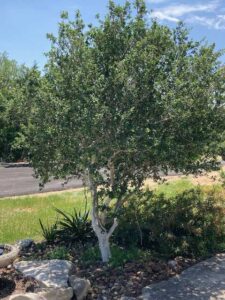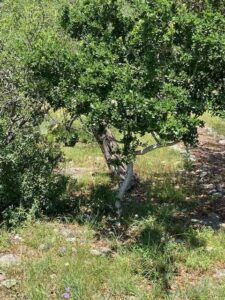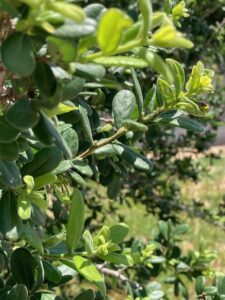Texas Persimmon
by CMG Betty J
Texas Pesimmon, Diopsyros texana, is a large shrub or small tree that grows prolifically in the Texas Hill Country and is native to the Edwards Plateau. Also known as Mexican Persimmon, Black Persimmon, Chapote or Chapote Prieto, it is a member of the Ebony Family. Its wood is very hard and in very large trees, the heartwood is black. The sapwood is yellow. Texas Persimmons usually grow 10-15 feet tall but in the southern part of its natural range, trees often grow to 35 feet or more. They are very common on hillsides and in brushy areas from Houston to Big Bend and south to Nuevo Leon in northeastern Mexico at elevations up to 4000’.
Persimmons have light gray to white bark that peels in rectangular strips to reveal a white, gray or pinkish layer underneath. Short, singular trunks are the norm, but some grow with multiple trunks. The single trunks branch out to form a broad crown. The leathery leaves are 1-2” long and are alternately attached. They have a rounded tip and are dark green on top with a lighter green underside. The underside is covered with white hairs.

Short trunk/Gray Bark

Young Persimmon

Persimmon Leaves
Trees are either male or female with male trees far outnumbering the female trees. The white flowers are urn-shaped and appear in March and April. Pollinated flowers produce small, round, black fruit about 1” in diameter. Most native wildlife dine on the fruits as soon as they ripen from late July until September.
Although slow-growing, Texas Persimmons are a valuable addition to any Central Texas landscape. Their shapely form, drought tolerance, and disease resistance provide a long-lived solution for a small space with full sun. They are deciduous in Central Texas and semi-evergreen in their southern range. In the southern range, they lose their leaves all at once in early spring in a pattern similar to live oak trees. Deer seldom browse the leaves.